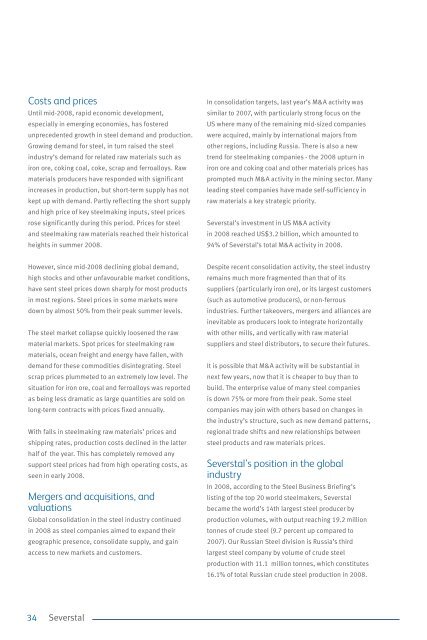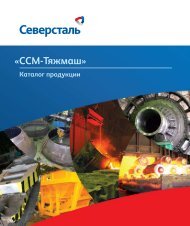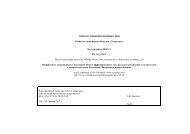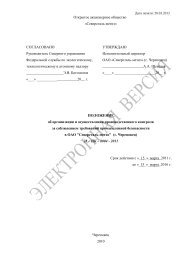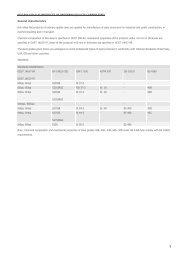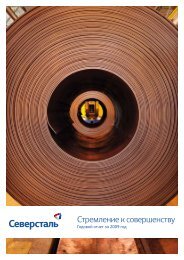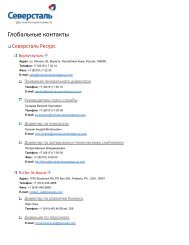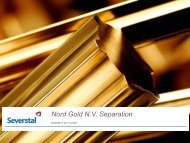Download PDF - Severstal
Download PDF - Severstal
Download PDF - Severstal
You also want an ePaper? Increase the reach of your titles
YUMPU automatically turns print PDFs into web optimized ePapers that Google loves.
Costs and pricesUntil mid-2008, rapid economic development,especially in emerging economies, has fosteredunprecedented growth in steel demand and production.Growing demand for steel, in turn raised the steelindustry’s demand for related raw materials such asiron ore, coking coal, coke, scrap and ferroalloys. Rawmaterials producers have responded with significantincreases in production, but short-term supply has notkept up with demand. Partly reflecting the short supplyand high price of key steelmaking inputs, steel pricesrose significantly during this period. Prices for steeland steelmaking raw materials reached their historicalheights in summer 2008.However, since mid-2008 declining global demand,high stocks and other unfavourable market conditions,have sent steel prices down sharply for most productsin most regions. Steel prices in some markets weredown by almost 50% from their peak summer levels.The steel market collapse quickly loosened the rawmaterial markets. Spot prices for steelmaking rawmaterials, ocean freight and energy have fallen, withdemand for these commodities disintegrating. Steelscrap prices plummeted to an extremely low level. Thesituation for iron ore, coal and ferroalloys was reportedas being less dramatic as large quantities are sold onlong-term contracts with prices fixed annually.With falls in steelmaking raw materials’ prices andshipping rates, production costs declined in the latterhalf of the year. This has completely removed anysupport steel prices had from high operating costs, asseen in early 2008.Mergers and acquisitions, andvaluationsGlobal consolidation in the steel industry continuedin 2008 as steel companies aimed to expand theirgeographic presence, consolidate supply, and gainaccess to new markets and customers.In consolidation targets, last year’s M&A activity wassimilar to 2007, with particularly strong focus on theUS where many of the remaining mid-sized companieswere acquired, mainly by international majors fromother regions, including Russia. There is also a newtrend for steelmaking companies - the 2008 upturn iniron ore and coking coal and other materials prices hasprompted much M&A activity in the mining sector. Manyleading steel companies have made self-sufficiency inraw materials a key strategic priority.<strong>Severstal</strong>’s investment in US M&A activityin 2008 reached US$3.2 billion, which amounted to94% of <strong>Severstal</strong>’s total M&A activity in 2008.Despite recent consolidation activity, the steel industryremains much more fragmented than that of itssuppliers (particularly iron ore), or its largest customers(such as automotive producers), or non-ferrousindustries. Further takeovers, mergers and alliances areinevitable as producers look to integrate horizontallywith other mills, and vertically with raw materialsuppliers and steel distributors, to secure their futures.It is possible that M&A activity will be substantial innext few years, now that it is cheaper to buy than tobuild. The enterprise value of many steel companiesis down 75% or more from their peak. Some steelcompanies may join with others based on changes inthe industry’s structure, such as new demand patterns,regional trade shifts and new relationships betweensteel products and raw materials prices.<strong>Severstal</strong>’s position in the globalindustryIn 2008, according to the Steel Business Briefing’slisting of the top 20 world steelmakers, <strong>Severstal</strong>became the world’s 14th largest steel producer byproduction volumes, with output reaching 19.2 milliontonnes of crude steel (9.7 percent up compared to2007). Our Russian Steel division is Russia’s thirdlargest steel company by volume of crude steelproduction with 11.1 million tonnes, which constitutes16.1% of total Russian crude steel production in 2008.Table 3. Largest steel-making companiesMillion metric tonnes crude steelSource: Steel Business BriefingOn the Russian market, which remains the mostimportant to us, we compete against NLMK, MMK andUral Steel in the production and distribution of flatrolledproducts to auto-making, pipe-making, machinerybuilding, construction and steel service centres.In the construction, metalware and engineeringindustries, we compete with MMK, ZSMK, Mechel SteelGroup and Maxi Group in the production and sale oflong products. These companies, as well as Ukrainianenterprises, are our principal competitors in the exportmarkets.<strong>Severstal</strong>’s competitiveadvantages<strong>Severstal</strong> maintained a leading position in the domesticmarket due, principally, to high production quality, wide2008 2007 Change year-on-year %Rank Output Rank OutputArcelorMittal 1 103.3 1 116.4 (11.3)Nippon Steel 2 35.6 2 35.3 0.8Baosteel 3 35.4 5 28.6 23.8HebeiI&S 4 33.3 - - -Posco 5 33.1 4 31.1 6.4JFESteel 6 33.0 3 33.9 (2.7)WuhanI&S 7 27.7 11 20.2 37.1TataSteel 8 24.4 6 26.5 (7.9)Anshan-Benxi 9 23.4 7 23.6 (0.8)Shagang 10 23.3 8 22.9 1.7US Steel 10 23.3 10 21.5 8.4ShandongI&S 12 21.8 - - -Gerdau 13 19.6 13 17.9 9.5<strong>Severstal</strong> 14 19.2 15 17.5 9.7Nucor 15 18.5 12 20.0 (7.5)Evraz 16 17.7 17 16.5 7.3Riva 17 17.2 14 17.9 (3.9)ThyssenKrupp 18 16.0 16 17.0 (5.9)Maanshan 19 15.0 18 14.2 5.6SumitomoMI 20 13.9 20 13.5 3.0product range, reliable deliveries and flexible paymentconditions.A constant drive to optimise costs helps us improve ourfinancial results and allows us to enter new markets. Wealso successfully satisfy growing customer demand formore technical support and maintenance.In export markets, we sell basic-quality productswhere the key competing factor is price. With sales ofinnovative products such as automobile body sheetsand strips, quality ranks in equal importance to price.Our long-term competitive advantage is having verticallyintegrated operations which provide us with security inraw materials. During the downturn vertical integrationallows us to source most of our raw materials fromwithin, and thus protect our margins.34 35


